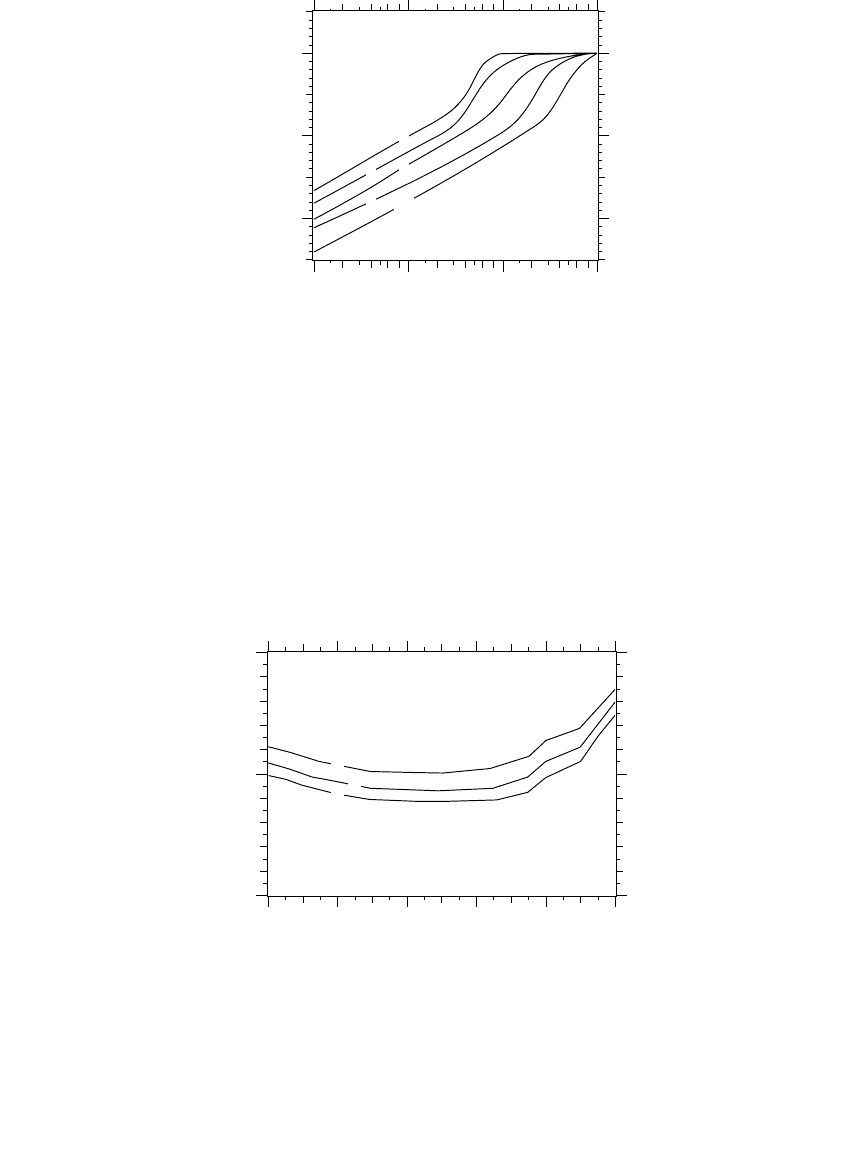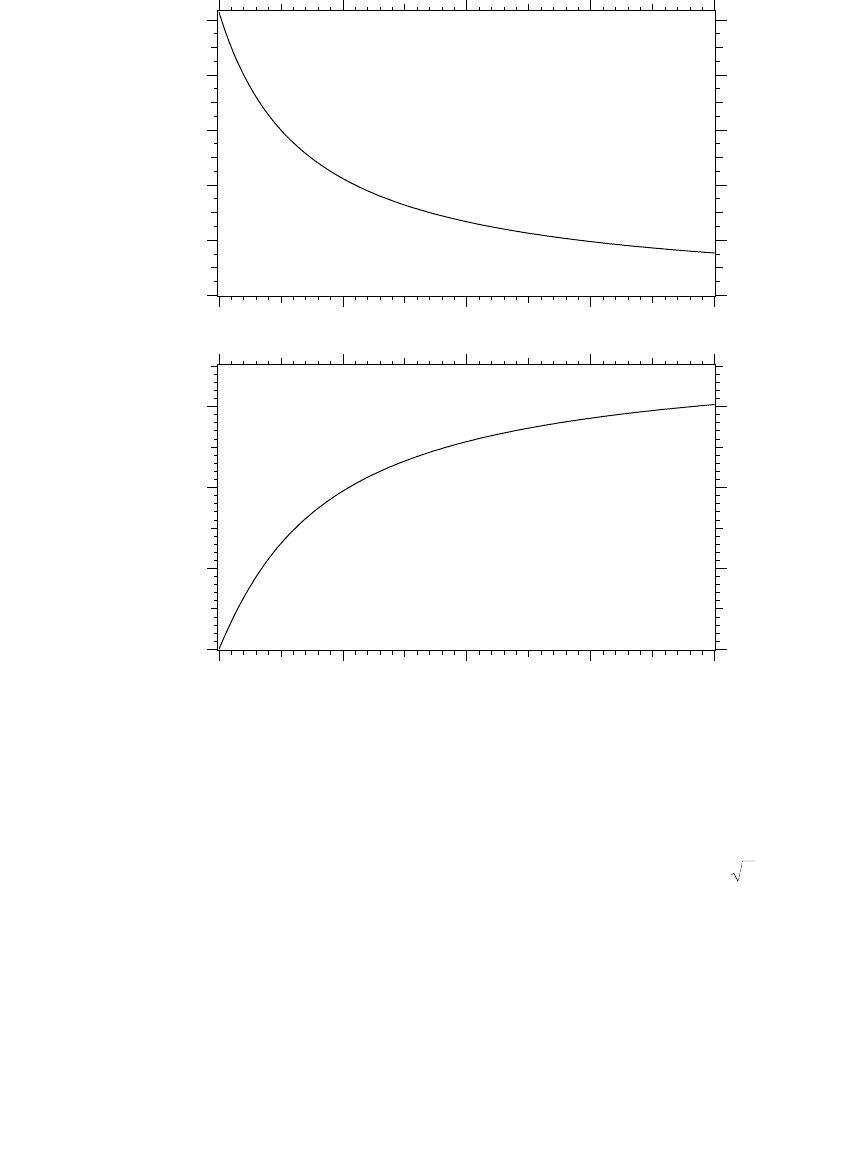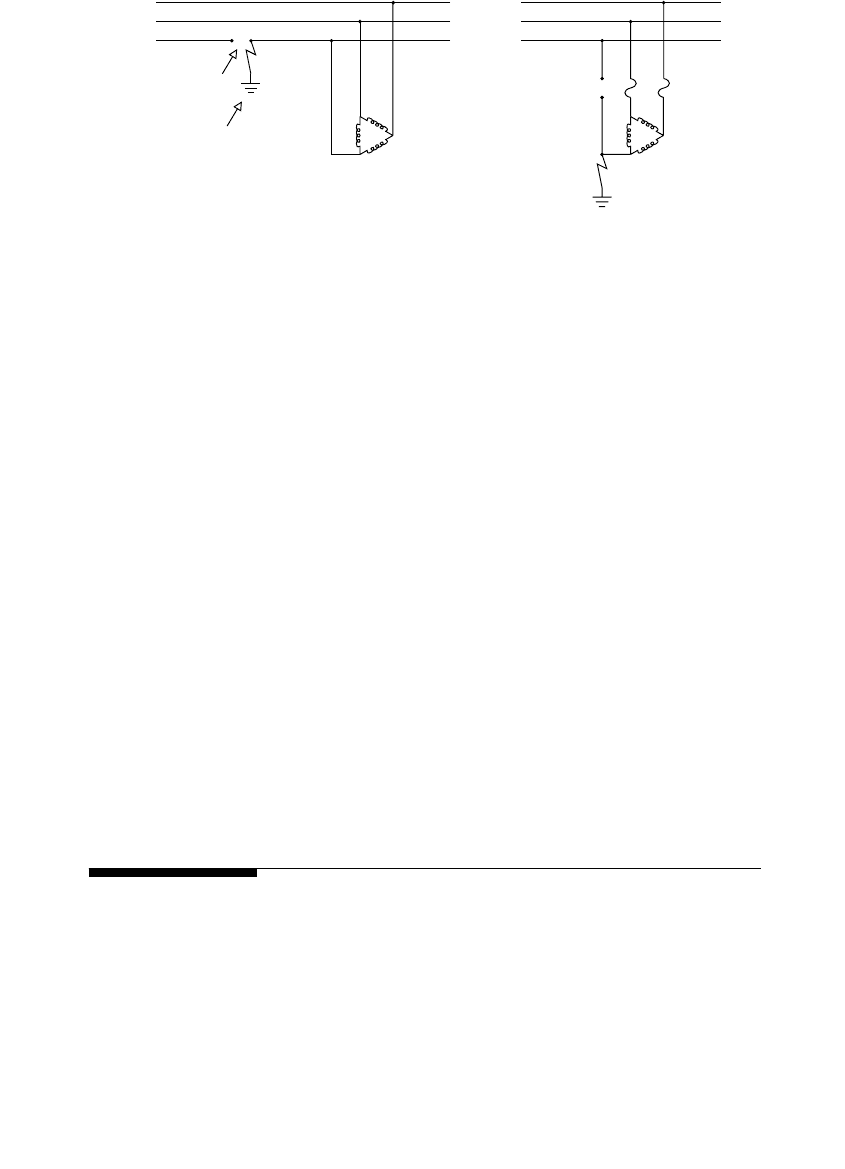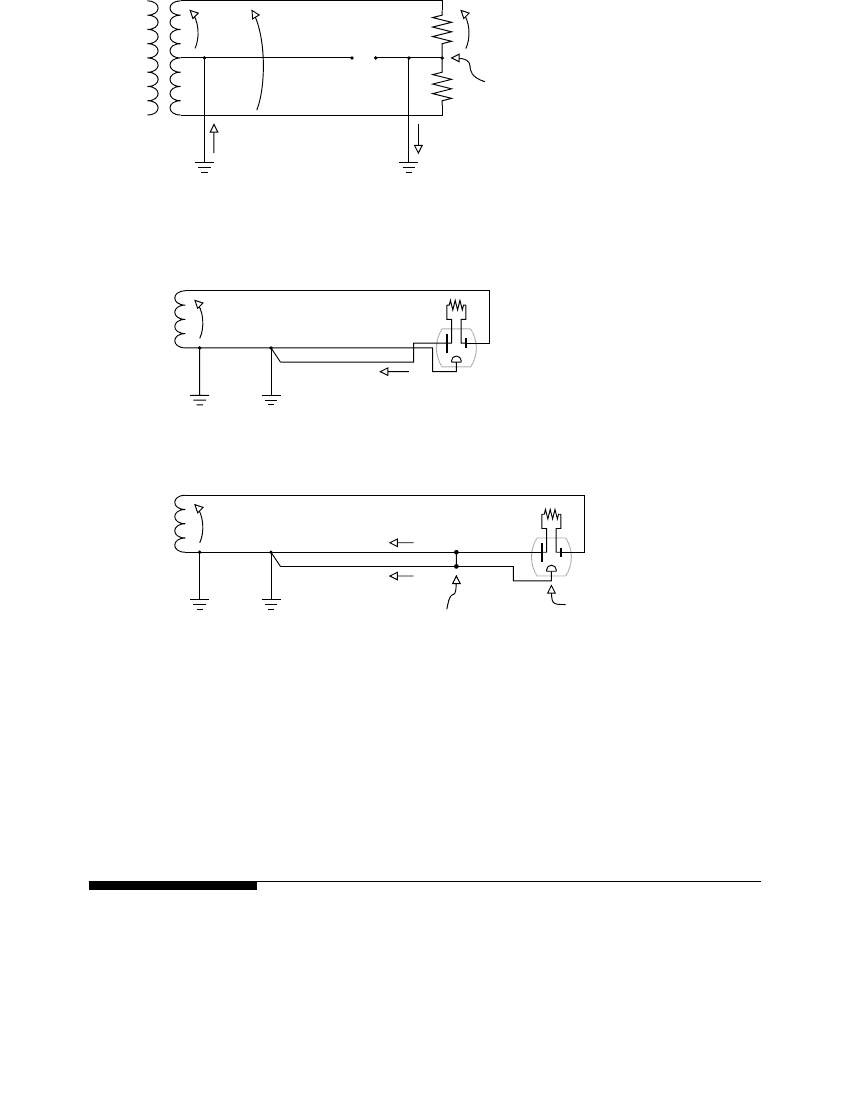Short T.A. Electric Power Distribution Handbook
Подождите немного. Документ загружается.


Grounding and Safety
659
•
Ground rod resistance and number of ground rods
— More ground rods
and lower rod resistances reduce overvoltages (see Figure 13.7). But
the results are not particularly sensitive to ground rod resistance
values.
•
Neutral reactor
— A neutral reactor on the substation transformer
causes a higher overvoltage, mainly for faults near the station.
Hydro Quebec staged faults on rural circuits and measured the neutral
voltages and currents (Rajotte et al., 1995). The measured neutral offsets
compared very well with simulations done with Lat’s modeling approach.
But, they compared well only if customer’s grounds were modeled. On this
circuit, the customer grounds contributed more to grounding the line than
the utility ground rods. There were three times more customer ground rods,
and their average resistance was almost eight times lower. It is not unusual
for customer grounds to be better than utility grounds, as customer grounds
are often tied to water pipes and wells. More extensive measurements of
ground rods and customer grounds on 16 rural feeders found an equivalent
of 47
W
for ground rods and 16
W
for customer ground connections (these
equivalents are the inverse of the average admittance) (Rajotte et al., 1995).
If the neutral conductor breaks, overvoltages are much higher. Mancao et
al. (1993) found overvoltages as high as 1.58 per unit on simulated systems
for faults downstream of an open point in the neutral. The worst case is for
a fault just past the break, but even a fault several miles from the open point
causes higher than normal overvoltages.
FIGURE 13.6
Overvoltages for different fault locations on feeders of different lengths. 3/0 ACSR phase
conductors, 1/0 ACSR neutral, 4-foot (1.2-m) spacings, four 25-
W
grounds/mile (normally, there
are many more grounds than this). (Adapted from Lat, M. V., “Determining Temporary Over-
voltage Levels for Application of Metal Oxide Surge Arresters on Multigrounded Distribution
Systems,”
IEEE Trans. Power Delivery
, 5(2), 936-946, April 1990. ©1990 IEEE. With permission.)
0 2 4 6
0.0
0.5
1.0
1.5
Distance from the station, miles
Maximum overvoltage in per unit
1791_book.fm Page 659 Monday, August 4, 2003 3:20 PM
(C) 2004 by CRC Press LLC

660
Electric Power Distribution Handbook
Figure 13.8 shows simulated divisions of current for several neutral sizes
for a fault near the end of the circuit. Near a line-to-ground fault, most of
the current is in the neutral. In the middle, more flows through the earth.
Near the station, additional current returns to the neutral. And, some current
returns via grounds beyond the fault location. Larger neutrals carry more
return current.
FIGURE 13.7
Effect of ground rod resistance and spacings. Each curve is labeled with the number of grounds
per mile. (Adapted from Lat, M. V., “Determining Temporary Overvoltage Levels for Applica-
tion of Metal Oxide Surge Arresters on Multigrounded Distribution Systems,”
IEEE Trans. Power
Delivery
, 5(2), 936-946, April 1990. ©1990 IEEE. With permission.)
FIGURE 13.8
Division of fault current between the neutral and earth. Armless construction, 336-kcmil phase
conductors, four 25-
W
grounds per mile. (Adapted from Mancao, R. T., Burke, J. J., and Myers,
A., “The Effect of Distribution System Grounding on MOV Selection,”
IEEE Trans. Power Delivery
,
8(1), 139-45, January 1993. ©1993 IEEE. With permission.)
1
2
4
8
16
1.0 10.0 100.0 1000.
1.2
1.3
1.4
Ground electrode resistance, ohms
Maximum overvoltage, per unit
A
B
C
Neutral size:
A: 336.4 kcmil
B: 3/0
C: 1/0
0 2 4 6 8 10
0
50
100
Distance from the station, miles
Fault current in the neutral, percent
1791_book.fm Page 660 Monday, August 4, 2003 3:20 PM
(C) 2004 by CRC Press LLC

Grounding and Safety
661
An IEEE Working Group (1972) stated that transformer saturation holds
down overvoltages based on transient network analyzer evaluations. But
others disagree. Field tests found that saturation did not lower the peak
voltage (Rajotte et al., 1995). A transformer core saturates when the flux is
highest. The flux is 90
∞
out of phase with the voltage. The peak flux occurs
when the voltage crosses through zero. So, when a transformer saturates, it
distorts the voltage but does not appreciably limit the peak voltage.
Normally, the highest overvoltages are for single line-to-ground faults, but
in some cases slightly higher overvoltages occur for double line-to-ground
faults. These cases normally involve large conductors (high
X/R
).
Spacer cable systems have higher overvoltages because of the messenger
wire (not because of the tighter phase and neutral spacings). An IEEE Work-
ing Group (1972) found overvoltages between 1.36 and 1.45 per unit with
spacer cable having a 5/16-in. or 3/8-in. copperweld messenger with a 30%
conductivity. If a spacer cable uses a lower-resistivity messenger or has a
separate neutral, overvoltages are similar to those of open-wire configura-
tions. ESEERCO (1992) simulated different spacer cable configurations and
found overvoltages of about 1.5 per unit on configurations with just a 3/8-
in. copperweld messenger. With a 1/0 ACSR neutral added to the spacer
cable, the overvoltages dropped to 1.3 per unit.
Underground cables normally have lower overvoltages. Rajotte et. al.
(1990) simulated overhead and underground systems and found that the
neutral shift was a factor of ten lower on underground systems. Urban
locations, whether overhead or underground, have many more grounds, so
overvoltages and other grounding issues such as stray voltage are less likely.
However, circuits of cables with tape shields or lead sheaths can have
significantly higher overvoltages. On these cables, the tape shields have very
high resistance. Figure 13.9 shows how the overvoltage on the unfaulted
phases increases with distance of the fault from the substation for an example
scenario. This example assumes that the sheath is perfectly grounded. If
poorly grounded, more current will return through the high-resistance sheath
and increase the overvoltage. Utilities normally use tape shield or lead
sheathed power cables in urban areas where distances are fortunately short.
The high resistance also contributes to transients; the
X/R
ratio is low enough
that faults often spark and cause transients at each zero crossing. In a resistive
circuit, when the arc clears at a zero crossing, the voltage builds up slowly,
which delays the arc breakdown. When the arc does restrike, a transient can
occur because of the trapped voltage just prior to the arc restrike.
13.2.2 Neutral Reactor
A reactor connected between the substation transformer neutral point and
the substation ground reduces ground fault currents. This limits duty on
equipment, but it reduces the effectiveness of the grounding system. During
line-to-ground faults, the voltages on the unfaulted phases are higher. A
1791_book.fm Page 661 Monday, August 4, 2003 3:20 PM
(C) 2004 by CRC Press LLC

662
Electric Power Distribution Handbook
neutral reactor of
X
W
adds 3
jX
W
to the zero-sequence impedance. The
overvoltage is most pronounced for faults near the substation. Beyond a few
miles, the line impedance dominates.
Figure 13.10 shows an example of the tradeoff between fault current at the
substation bus and neutral reactor impedance on a 12.47-kV system. A 0.5
W
reactor increases the
Z
0
/
Z
1
ratio to 3.1, which reduces the fault current to
under 6 kA at the substation bus while still keeping the overvoltage below
130%. A reactor larger than this must be considered carefully to avoid sub-
jecting metal-oxide arresters and customer’s loads to undue overvoltages.
This graph was developed from a simplified equation for overvoltages.
With all circuit resistances equal to zero, the voltage magnitude in per unit
on the worst unfaulted phase for a bolted single line-to-ground fault sim-
plifies (Westinghouse Electric Corporation, 1950) to
where
X
0
=
X
0
,circuit
+ 3
X
reactor
13.2.3 Overvoltages on Ungrounded Systems
Many older distribution systems are ungrounded, typically operating at 2400
or 4800 V. Although ungrounded systems have no intentional ground, they
FIGURE 13.9
Voltage on the unfaulted phases for a system with 500-kcmil, triplex, copper-conductor, tape-
shield cables. 12.47 kV,
Z
1
= 0.0292 +
j
0.0355
W
/1000 feet,
Z
0
= 0.3765 +
j
0.2882
W
/1000 feet,
Z
src
=
j
0.7
W
.
0 1 2 3 4
1.0
1.2
1.4
1.6
Distance of the fault from the station, miles
Overvoltage on the unfaulted phases
at the fault location in percent
V
XXXX
XX
=
++
+
1 732
2
0
2
01 1
2
10
.
1791_book.fm Page 662 Monday, August 4, 2003 3:20 PM
(C) 2004 by CRC Press LLC

Grounding and Safety
663
are grounded through the line’s capacitance. Under normal conditions, the
phase-to-ground voltage equals the phase-to-phase voltage divided by
if the total line-to-ground capacitance on each phase is the same.
Ungrounded systems may have extra-high overvoltages under certain
conditions:
•
Resonance
— The line-to-ground capacitance can resonate with the
system reactance.
• Arcing ground faults — A restriking ground fault can create significant
line-to-ground voltage.
FIGURE 13.10
Tradeoff between overvoltage on the unfaulted phases and fault current for a single line-to-
ground fault at the substation bus for different size neutral reactors. (12.47-kV circuit with a
20-MVA, 9% transformer, subtransmission impedance neglected)
0 1 2 3 4
0
2
4
6
8
10
0 1 2 3 4
100
120
140
160
Current for a line-to-ground fault, kA
Reactor reactance, ohms
Overvoltage on the unfaulted phases
at the substation, percent
3
1791_book.fm Page 663 Monday, August 4, 2003 3:20 PM
(C) 2004 by CRC Press LLC

664 Electric Power Distribution Handbook
The main impact of these overvoltages is stress on insulation and impact
on arresters (higher rated arresters are necessary). A bolted line-to-ground
fault on one phase draws very little current on an ungrounded system. The
current is normally much less than 10 A, so the system may continue sup-
plying power. This is an operational advantage of the ungrounded system.
Because it can operate through line-to-ground faults, ungrounded systems
may have higher reliability. Most lower-voltage ungrounded systems (2400
or 4800 V) are very resistant to trees.
Figure 13.11 shows a simplification of an ungrounded system that shows
how resonances can create overvoltages.* For a bolted single line-to-ground
fault on a phase, the voltages on phases B and C can become extremely high
if the system capacitance resonates with the inductance, which occurs when
X = X
C
/3
where
X = reactance of the system, W
X
C
= line-to-ground capacitance, W
The overvoltage reaches a maximum when at the resonant point and can
reach significant voltages for ratios of X
C
/X of up to 15. Normal line capac-
itances and reactances are well away from the resonant point; even cable
capacitances are too low to cause resonance. For example, 10 mi (16 km) of
cable with a capacitance of 0.5 mF/mi (0.9 mF/km) has an impedance of 530
W, and line impedances are less than 1 W/mi. Even with several circuits in
FIGURE 13.11
Ungrounded system schematic.
* The simplified circuit shows how resonance occurs, but the circuit is actually more complicated
than shown. The capacitance is not necessarily lumped on the source side of the line impedance,
it is distributed along the line (although circuit taps may concentrate the capacitance at points
on the line). The figure also ignores the line-to-line capacitance and the system load.
Equivalent circuit referred to one phase
R
X
X
C
RX
X
C
3
E
1791_book.fm Page 664 Monday, August 4, 2003 3:20 PM
(C) 2004 by CRC Press LLC

Grounding and Safety 665
parallel (more capacitance), such resonances are unlikely. For a more thor-
ough analysis, see Peterson (1951).
Resonances can occur when high reactances are accidentally connected to
ground. Figure 13.12 shows ground fault scenarios that may cause overvolt-
ages when three-phase distribution transformers become connected to ground.
Ungrounded systems are also susceptible to arcing ground faults. An
intermittent, restriking fault from ground to a phase conductor may spark
high voltages, possibly as high as five per unit. Consider the equivalent
single-phase circuit in Figure 13.11. This series circuit is a classic restriking
circuit often studied for switching capacitive loads; but now, the restriking
is in an arc to ground instead of in the circuit interrupter. The voltage can
ratchet up as the restriking charges the system capacitance. Since the inter-
mittent ground fault may last for hours, this overvoltage mode subjects
equipment to continued overvoltages. The overvoltages are likely to be
chaotic and random because of the random restriking times.
Fortunately, end users do not see the overvoltages from neutral shifts or
from arcing ground faults. The overvoltage is line to ground, and all loads
are connected line to line. But utility equipment insulation from the primary
to the equipment case does see the voltage, especially surge arresters, which
are sensitive to overvoltages.
13.3 Equipment/Customer Grounding
The National Electrical Safety Code (NESC) (IEEE C2-1997) places several
requirements on grounding systems. The NESC requires effective grounds on
• Surge arresters
• Primary, secondary, and common neutrals
• Unguarded metal or metal-reinforced supporting structures
FIGURE 13.12
Accidental connections of reactances to ground that may cause high overvoltages on unground-
ed systems.
Blown fuse
Ground fault
Ground fault
Open conductor
1791_book.fm Page 665 Monday, August 4, 2003 3:20 PM
(C) 2004 by CRC Press LLC

666 Electric Power Distribution Handbook
• Other intentionally grounded wires
• Instrument transformers
• Cable concentric neutrals
• Most equipment including transformers, capacitors, regulators,
reclosers, and sectionalizers
• Uninsulated guy and messenger wires
• Customer meters
Some items that may be ungrounded on overhead circuits are insulators,
cutouts, and some open-air switches. For multigrounded systems, the
grounded conductor may serve as the ground for many applications. On a
multigrounded system, the NESC requires ground electrodes at transformer
locations and at customer meters. For an effectively grounded neutral (from
an NESC safety perspective) there must be at least four grounds in each
mile (1.6 km) of the entire line. Customer meter grounds do not count (they
are not necessarily under the control of the utility). Also, the neutral must
be continuous.
The NESC does not allow the earth as the sole conductor for any part of
the circuit.
On systems without a multigrounded neutral, where a grounding elec-
trode is required, it must be less than 25 W. If it is higher than that, another
grounding electrode must be made. The second electrode must be at least 6
ft (1.8 m) from the first. Note that there is no requirement on the final
resistance (it can still be greater than 25 W and meet this rule). It should be
low enough so that a protective device will clear for a fault from the primary
through the grounding electrode.
The NESC does not require a specific grounding resistance for multi-
grounded systems. Multigrounded systems achieve their performance
mainly by having many grounds in parallel, so the resistance of individual
electrodes is less significant. Still, many utilities use the ungrounded NESC
approach for all grounding points: drive one rod, if it is more than 25 W,
drive another.
At least 20 ft (6.1 m) must separate grounding electrodes of different
systems (Clapp, 1997; IEEE C2-1997). The primary and secondary are “dif-
ferent systems.” Grounding electrodes of different systems may not be
bonded above or below ground.
The NESC requires grounding conductors for surge arresters to be at least
#6 copper or #4 aluminum. Other grounding electrodes may be smaller, but
they must be able to handle the fault current they will see. For multigrounded
systems, ground down leads from the neutral to the grounding electrode
will normally not carry significant current. The critical connection is between
the equipment frame and the neutral. First and most importantly, make sure
there is such a connection. The connection between the frame and the neutral
must be designed to take the entire fault current for a line-to-ground fault
1791_book.fm Page 666 Monday, August 4, 2003 3:20 PM
(C) 2004 by CRC Press LLC

Grounding and Safety 667
from the line to the equipment case. Since the fault current duration plays
a role in whether the wire will handle the fault, we must consider the fault
interrupter. For most applications where normal-sized fuses are used, a #4
or #6 copper bonding conductor is sufficient. For situations with high fault
currents and where a station breaker clears the fault, a larger conductor or
parallel conductors may be needed.
Since the tank-to-neutral connection is critical on multigrounded systems,
on transformers, utilities typically tie two connections from the transformer
tank. One runs from the tank to the pole ground lead, which is attached to
the primary neutral. Another runs from the secondary neutral terminal of
the transformer (X2) to the neutral.
13.3.1 Special Considerations on Ungrounded Systems
Systems that do not have a multigrounded neutral — ungrounded or uni-
grounded systems — have special grounding considerations. Without the
multigrounded neutral, the secondary neutral grounding system is the whole
grounding system. If a transformer fails from the primary to the secondary
(a high-to-low fault), the secondary grounding system must be effective
enough to prevent unsafe voltages on customer wiring. Crews should make
sure that distribution transformers are grounded as well as possible and that
customer meters are grounded as well as possible.
On systems without a multigrounded neutral, the NESC requires the pri-
mary surge arrester to be separate from the secondary ground. The NESC
does allow interconnection of the primary and secondary grounds through
a spark gap as long as the 60-Hz breakdown value of the gap is at least twice
the primary circuit voltage but not necessarily more than 10 kV. If a spark
gap is used, an additional ground electrode must be attached, not including
the customer’s grounds; and the extra ground must be at least 20 ft (6.1 m)
from the arrester’s grounding electrode.
13.3.2 Secondary Grounding Problems
Many complaints are related to grounding problems on the secondary. Some
common problems are shown in Figure 13.13. One of the most common
power quality complaints is due to an open secondary neutral. If the neutral
is open or has a poor connection, the unbalanced current must return through
the grounding electrodes (these can have high impedance). The customer
may see this as light flicker, and high voltage may occur on the less loaded
of the two secondary legs.
Another common problem on secondary systems is when load is connected
to the equipment safety ground (the green wire) instead of the neutral wire,
or the ground wire is wrongly connected to the neutral wire somewhere
within the facility. Both situations violate the National Electrical Code (NFPA
1791_book.fm Page 667 Monday, August 4, 2003 3:20 PM
(C) 2004 by CRC Press LLC

668 Electric Power Distribution Handbook
70, 2002). Currents flowing in the grounding conductor wire increase shock
hazards. Other secondary problems that can occur are isolated grounds,
ground loops, and missing safety grounds.
13.4 Ground Rods and Other Grounding Electrodes
The earth, the soil, has very low resistance, primarily because there is so
much of it. The trick is getting from the concentrated grounding electrode
to the soil beneath that is almost infinite by comparison.
FIGURE 13.13
Common secondary problems.
Open Secondary Neutral
Customer’s ground
at the meter
House load
Transformer
ground
Unbalanced
current
High neutral-to-earth
voltage
High or low voltage
(depending on load balance)
Neutral and Safety Ground Reversed in the Facility
120 V 240 V
Service
panel
Load current on the ground wire
120 V
Hot
Neutral
Safety ground
Neutral and Safety Ground Connected in the Facility
Service
panel
Improper neutral/ground
interconnection
120 V
Hot
Neutral
Safety ground
High voltage from
the equipment case
to earth
1791_book.fm Page 668 Monday, August 4, 2003 3:20 PM
(C) 2004 by CRC Press LLC
